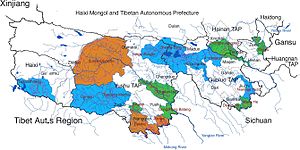| Sanjiangyuan | |||||||||
|---|---|---|---|---|---|---|---|---|---|
 Sanjiangyuan National Nature Reserve Wildlife conservation Shrubland or forest conservation | |||||||||
| Chinese name | |||||||||
| Traditional Chinese | 三江源國家級自然保護區 | ||||||||
| Simplified Chinese | 三江源国家级自然保护区 | ||||||||
| Literal meaning | Source of Three Rivers National Nature Reserve | ||||||||
| |||||||||
| Tibetan name | |||||||||
| Tibetan | གཙང་གསུམ་འབུང་ཁུངས་རང་བྱུང་སྲུང་སྐྱོབ་ཁུལ། | ||||||||
| |||||||||
The Sanjiangyuan (Chinese: 三江源; lit. 'Source of Three Rivers'), is an area of the Tibetan Plateau in Qinghai province, China which contains the headwaters of three great rivers of Asia: the Yellow, the Yangtze, and the Mekong. Parts of the area were protected as the Sanjiangyuan National Nature Reserve (SNNR), also called the Three Rivers Nature Reserve. The reserve consisted of 18 subareas, and each contained three zones which were managed with differing degrees of strictness. In 2015, the Chinese government decided to implement a new national park system, and created Sanjiangyuan National Park, which is set to open officially in 2020.[1]
Along with wetland and waters protection, other ecological values, such as grassland, forest, and wildlife enhancement, have also been presented as goals. To advance the goals of the SNNR uncontrolled or poorly managed mining, logging, hunting, and grazing have been curtailed. Foreign and other mining firms have replaced the uncontrolled miners, trees have been planted, and measures have been taken to protect endangered species. To protect the grasslands, pastoralists are not permitted to graze their animals in designated ‘core zones’ (see below), and grazing is supervised elsewhere in the SNNR. In addition, residents have been resettled from core zones and other grassland areas of the SNNR, and rangeland has been fenced and is in the process of being privatized throughout the Sanjiangyuan Area.[2]
- ^ Wang, Yan (19 May 2017). "China's first national park, an experiment in living with snow leopards". Mongabay. Retrieved 19 November 2019.
- ^ Plateau Perspectives